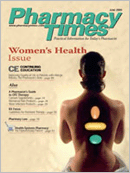Publication
Article
Pharmacy Times
Ovulation-Prediction Testing Kits: A Woman's Choice
Author(s):
For many women who wish to conceive, the use of an ovulation-prediction product can be an easy and effective means to detect ovulation. Currently, a variety of OTC products are available for consumers to use for increasing the chances of pinpointing the optimal time to conceive. These products include urinary hormone tests, basal thermometers, fertility microscopes, and saliva tests. Each type of product has a different method of obtaining results. Women should select the type of test or tests that suits them best (Table 11).
Urinary Hormone Tests
Tests that require a urine sample to predict ovulation use monoclonal antibodies specific to the luteinizing hormone (LH) to detect the surge of LH. LH is present throughout the menstrual cycle, but it increases significantly 24 to 36 hours prior to ovulation. This sudden increase is often referred to as the LH surge. When the test is used, the LH surge is revealed by a difference in the color or color intensity from the results of the prior day's testing. Generally, early-morning collection is recommended because the LH surge usually begins early in the day and the urine concentration may be relatively consistent at that time.2
Some ovulation tests do not identify a specific time of day to conduct the test, but they require that the times are consistent from day to day. Prior to using a test, a woman should determine the typical length of her cycle, in order to know when to start testing. Testing should begin 2 to 4 days before the estimated date of ovulation. Whereas, in general, ovulation-test-kit results are accurate, certain factors can cause an increase in LH levels that produces falsepositive test results (Table 22,3).
Basal Thermometers
For several years, women have relied on the method of measuring their basal body temperature (BBT) to determine ovulation. Basal thermometers have smaller graduations than regular thermometers and can detect very small fluctuations in temperature. Basal temperature is one's temperature upon waking each morning. Typically, a woman takes her temperature each morning before any activity and records the result. Usually, a women's BBT is below normal during the first part of her menstrual cycle but rises to a level closer to normal after ovulation (ie, 98.6?F).3 The rise in temperature is caused by an increased progesterone level after the follicle releases the egg.4
Because the variation in temperature is small, it is crucial to take one's temperature as directed. Temperatures should be taken at the same time every morning, before rising, after at least 5 hours of sleep. Several factors may affect the accuracy of the results, such as emotions, movements, and infections. Eating, drinking, talking, and smoking should not occur within 30 minutes prior to measuring the BBT.1
Fertility Microscopes
The most recent devices to be marketed for detecting ovulation are fertility microscopes. These reusable devices allow women to examine dried saliva samples using an illuminated microscope about the size of a lipstick container. Hormonal changes that occur before, during, and after ovulation directly affect saliva electrolyte concentrations.1 When a woman ovulates, estrogen levels rise, causing the amount of salt in the saliva to increase. When dried saliva samples are viewed under a microscope, a fern-like pattern can be observed during fertile periods. The fern pattern appears in test samples ~3 to 4 days prior to ovulation and continues until 2 to 3 days postovulation. During a woman's nonfertile time, nonrandom dotted lines or a bubble pattern appears.
Testing should be performed on a daily basis in the morning prior to brushing one's teeth, eating, or drinking. If the test is performed later in the day, one should wait at least 2 hours after eating or drinking so as not to alter the test results.
Saliva Electrolyte Test
The OvaCue Fertility Monitor measures the concentration of electrolytes in the saliva to predict ovulation. It measures saliva sodium and potassium by an electrochemical mechanism.1,2 The patient applies a spoonsized sensor to the tongue for 5 seconds each morning, and the OvaCue will automatically display and record the individual's fertility for that day. The OvaCue tracks the readings in memory and indicates the most fertile period from 5 to 7 days before ovulation until ovulation is confirmed.1 A vaginal sensor also can be purchased with the monitor to confirm ovulation by measuring electrolyte changes in the vaginal mucus. The data from the monitor can then be downloaded to a computer for interpretation.2
Conclusion
Selection of an ovulation-predictor test involves considerations of cost, ease of use, and convenience. If pregnancy does not occur after >3 months of using these products, women should be advised to see their health care provider. Women with medically diagnosed fertility problems should ask their physician whether the use of these products is suitable for them.
Ms. Terrie is a clinical pharmacy writer based in the northern Virginia area.
For a list of references, send a stamped, self-addressed envelope to: References Department, Attn. A. Stahl, Pharmacy Times, 241 Forsgate Drive, Jamesburg, NJ 08831; or send an e-mail request to: [email protected].

Newsletter
Stay informed on drug updates, treatment guidelines, and pharmacy practice trends—subscribe to Pharmacy Times for weekly clinical insights.






